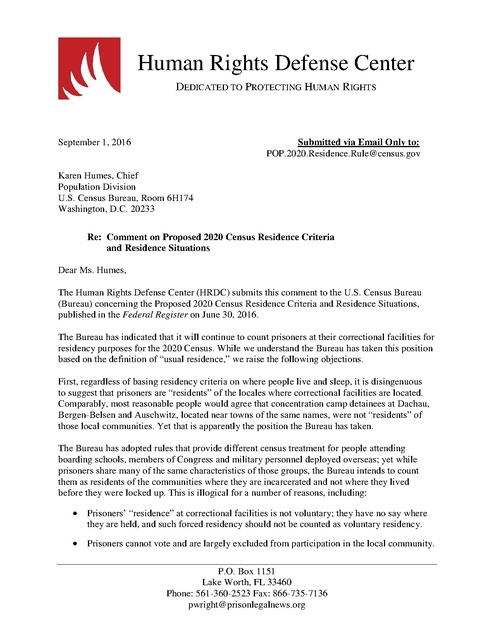HRDC comment filed with Census Bureau re counting prisoners - Sept 2016
Download original document:

Document text

Document text
This text is machine-read, and may contain errors. Check the original document to verify accuracy.
Human Rights Defense Center DEDICATED TO PROTECTING HUMAN RIGHTS September 1, 2016 Submitted via Email Only to: POP.2020.Residence.Rule@census.gov Karen Humes, Chief Population Division U.S. Census Bureau, Room 6H174 Washington, D.C. 20233 Re: Comment on Proposed 2020 Census Residence Criteria and Residence Situations Dear Ms. Humes, The Human Rights Defense Center (HRDC) submits this comment to the U.S. Census Bureau (Bureau) concerning the Proposed 2020 Census Residence Criteria and Residence Situations, published in the Federal Register on June 30, 2016. The Bureau has indicated that it will continue to count prisoners at their correctional facilities for residency purposes for the 2020 Census. While we understand the Bureau has taken this position based on the definition of “usual residence,” we raise the following objections. First, regardless of basing residency criteria on where people live and sleep, it is disingenuous to suggest that prisoners are “residents” of the locales where correctional facilities are located. Comparably, most reasonable people would agree that concentration camp detainees at Dachau, Bergen-Belsen and Auschwitz, located near towns of the same names, were not “residents” of those local communities. Yet that is apparently the position the Bureau has taken. The Bureau has adopted rules that provide different census treatment for people attending boarding schools, members of Congress and military personnel deployed overseas; yet while prisoners share many of the same characteristics of those groups, the Bureau intends to count them as residents of the communities where they are incarcerated and not where they lived before they were locked up. This is illogical for a number of reasons, including: • Prisoners’ “residence” at correctional facilities is not voluntary; they have no say where they are held, and such forced residency should not be counted as voluntary residency. • Prisoners cannot vote and are largely excluded from participation in the local community. P.O. Box 1151 Lake Worth, FL 33460 Phone: 561-360-2523 Fax: 866-735-7136 pwright@prisonlegalnews.org Page |2 • There is a disparate racial impact when black and Latino prisoners, who are overrepresented in our nation’s prison system, are counted as “residents” of the primarily white, rural communities where prisons are often located – for example, the many correctional facilities sited in upstate New York. • The location of prisoners at any given facility is not static; prisoners are regularly transferred from one prison to another, thus it cannot reasonably be said that a given facility is their “usual residence.” In the latter regard, speaking from my own empirical experience, I was incarcerated in Washington State prisons for 17 years prior to my release in 2003; during that time I was transferred 7 times. Our associate director, Alex Friedmann, served 10 years in both county jails and state prisons prior to his release in 1999, and during that period served time at 6 different facilities. Following our release we both returned to our homes – our residences – where we had lived before we were incarcerated. In fact, around 95% of people presently in prison will one day be released. Does the Bureau seriously think they will remain at the prison or the community surrounding the prison upon their release? Or is it more likely that they will return to their pre-incarceration homes, families and children – i.e., the residences where they lived prior to being imprisoned? Note that upon release, prisoners are typically given a small amount of “gate money” and a bus ticket or other means of transportation. Obviously, prison officials recognize that most prisoners will not be staying at or near the prison upon their release, but will return home – thus the prison system provides them the means of getting there. If correctional facilities were truly prisoners’ “residence,” which is the position the Bureau has taken, then bus tickets upon release wouldn’t be necessary. That makes no sense, of course, just as the Bureau’s policy of counting prisoners as residents of the facilities where they are incarcerated makes no sense. Further, note that city and county jails primarily hold pre-trial detainees who have not been convicted and are awaiting trial. As such, they are eligible to vote to the same extent as other citizens so long as they meet other applicable eligibility requirements. And when pre-trial detainees vote, it is not as residents of the district where the jail is located; rather, they vote via absentee ballot for the district where they resided before being incarcerated – i.e., their actual residence. 1 Approximately 2.3 million people are incarcerated in prisons and jails in the United States, and the Bureau’s practice of inaccurately reporting the residences of those individuals as being the communities where the facilities are located is as great an error as failing to accurately report the entire state populations of North Dakota (756,927 population), Wyoming (586,107 population) and Vermont (626,042 population), combined. 2 1 See: www.aclu.org/files/pdfs/votingrights/votingwhileincarc_20051123.pdf and www.lavote.net/home/votingelections/voting-options/vote-by-mail/inmate-voting (for Los Angeles County) 2 Based on Bureau estimates as of July 1, 2015, available at http://factfinder.census.gov/faces/tableservices/jsf/pages/productview.xhtml?src=bkmk Page |3 While we realize the Bureau has proposed to “incorporate similar group quarters information in the standard Redistricting Data (Pub. L. 94-171) Summary File for 2020,” that simply does not go far enough because the actual Census data will continue to count prisoners as residing where correctional facilities are located, which is not accurate. In conclusion, the Census Bureau is tasked with conducting a decennial national census pursuant to Article I, Section 2 of the U.S. Constitution. We submit that counting prisoners as residents of the local communities where correctional facilities are located is inaccurate and skews the census results. If the Bureau endeavors to ensure accuracy in its work, that practice must end; the census should be done correctly or not at all if the results are flawed. Thank you for your time and attention in this regard. Sincerely, Paul Wright Executive Director, HRDC

